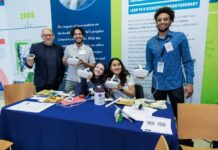OMS: True-To-Life Training – Without Risking Lives
By
Jack Pottle
Virtual reality shook a lot of people by its popularity outside of entertainment. What was once a dream to immerse the user in video game worlds, has now become a widely adopted method of training. Arguably, where it is having the most impact – by saving real lives – is in healthcare.
Medical Error: Healthcare’s Distressing Truth
Medical error is the third leading cause of death in hospitals worldwide, behind only cancer and heart disease. This is a terrifying statistic, and due in part to a decrease in effective training.
Increased burdens on healthcare systems (rising populations, restrictive budgets) mean that clinicians get too little time to learn and are often unsupported by training that is cost and time effective.
Traditionally, students are trained through a pretend clinical environment, where manikins and actors recreate real life emergencies in which clinicians treat the patient as they would do in real life. These are supervised by expert faculty, participants are then given a verbal debrief, where they are told how to improve.
In the aviation industry, repeated simulation is necessary to maintain skills and avoid the event of human error. On the other hand, healthcare professionals (who must adhere to the similar levels of caution) which require the same caution, typically get access to only one or two simulation sessions a year.
Resource constraints – space, time and money – mean it is almost impossible to get clinicians through repeated simulation, so skills are rarely maintained, and patients are put at risk.
Overcoming Constraints With VR
Oxford Medical Simulation has developed a platform that leverages VR to allow healthcare professionals to practice treating patients in true-to-life clinical scenarios without risking lives.
With the OMS platform learners put on VR headsets and become immersed in virtual clinical environments. Here, they are presented with acutely unwell patients who they must assess and manage as they would in the real world.
Learners can take a patient history, examine, investigate, diagnose and treat, all the while interacting with their virtual team.
Powered by artificial intelligence, the virtual patients have a rich history and are able to respond dynamically to the treatment they are given. These responses are both conversational and physiological – the patient will start to look better, their vital signs change, and they respond differently depending on the care provided.
Every action a learner takes within the scenario is logged by the OMS feedback engine. Once learners have completed the scenario, they are able to see what went well and what needs to be improved upon. They also receive an overall performance score to help track their progress over time.
All feedback is linked out to guidelines allowing further learning around the clinical cases, including with peers and mentors. Institutions use it to help identify struggling students in order to offer further opportunities for learning and practice.
Healthcare, Anywhere
The OMS VR-based system allows simulation-based training to be delivered at scale. Requiring nothing more than an Oculus kit and a compatible laptop, students can immerse themselves in scenarios as often as they like.
Scenarios are repeatable and the system is portable to enable flexible training. In addition, the entire system is customizable to allow institutions to build comprehensive learning packages around the scenarios.
OMS VR simulation creates valuable operational efficiencies within healthcare training and there is an abundance of evidence to support the educational benefits of VR-based training.
This is because VR simulation allows students to learn from experience – which is more effective than learning from theory. This is as true in healthcare as it is in everyday life.
Using VR simulation, the concept of blended learning – where theoretical study in the classroom is followed by practice – is made possible. Students can be taught the principles of recognizing and treating a condition, then enter VR immediately afterwards to practically reinforce that learning.
The Road Ahead
This is precisely how the OMS technology is being used at the OxSTaR Centre at Oxford University. Medical students have been using the OMS platform to support theoretical, classroom based learning with the practical application of that knowledge in virtually simulated environments.
Oxford found that its students were not getting enough access to simulation and needed a way to widen this accessibility and provide flexibility to fit students’ busy schedules.
Rosie Warren, Centre Manager at OxSTaR commented: “It’s encouraging to see how quickly our students have adopted the technology and I’m excited to see how they progress clinically as they use it more and more. Simulation is a vital part of medical education and students just don’t get to do it enough. The OMS platform allows learners to enter simulation as often as they like to transfer their knowledge to practice.”
Implementing VR simulation to empower blended learning has proven to be popular with the students at Oxford. Students using the OMS platform recognize its capacity to increase their confidence and competence in applying their learning to practice in the clinical environment.
Training doctors in a way that boosts their confidence is crucial to how they will cope with the demands of a career in healthcare. 2018 reports suggested that only 43% of junior doctors across the UK continued on to further training after their first two years of practice on the wards.
With so many newly-qualified clinicians leaving the profession shortly after medical school it has never been more relevant to address the likelihood that established training methods are not appropriately equipping students for the realities of working in the modern-day healthcare system.
What is more, the potential social impact of democratizing healthcare training is immeasurable. In the developing world – where healthcare resources are often scant and dangerously overstretched – the prospect of offering light-touch, cost-effective and scalable training is game changing.
VR technology offers us countless exciting opportunities to augment our experiences. What is particularly exciting about it is the potential to help the healthcare professional of the future to be more confident, well-practiced and sharper in their clinical reasoning, leading to more lives saved and improvements in patient care around the world.
Jack Pottle is the Chief Medical Officer at Oxford Medical Simulation


